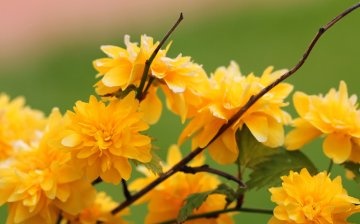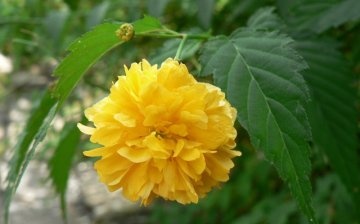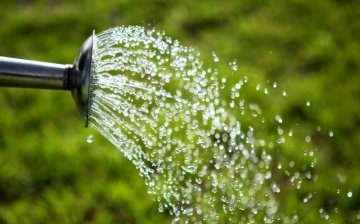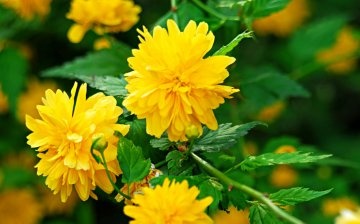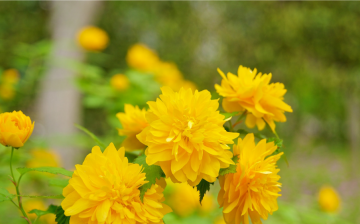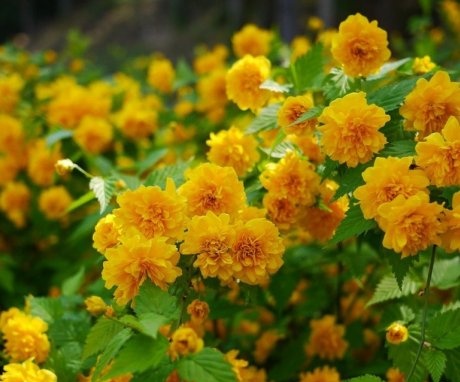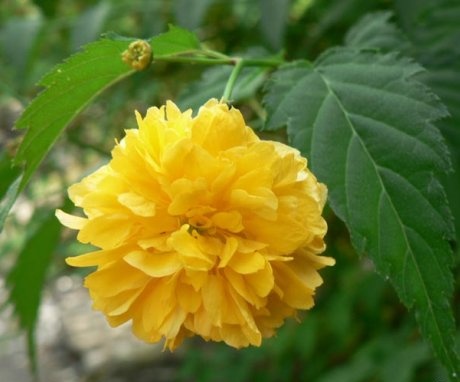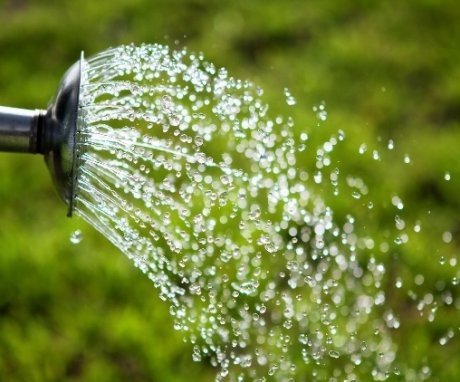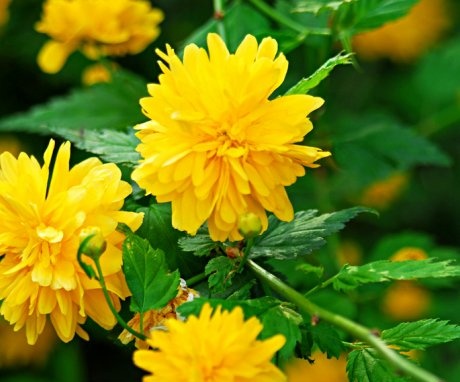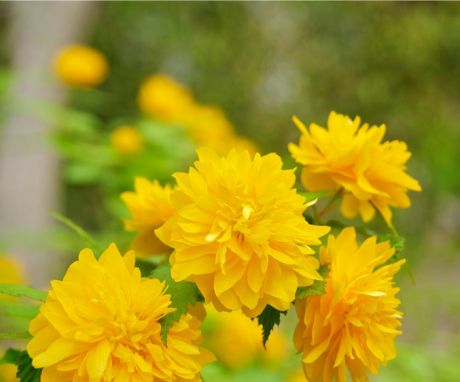Kerria japonica - deciduous ornamental shrub for your garden
Kerria Japanese - bush, it grows very quickly, it reaches 3 m in length, its shoots are straight and light green, because of such shoots, the bushes look like ordinary grass. In the wild, the flower grows in the mountains and forests of China and Japan. There, the plants are 3 m high, and in central Russia, kerria grows up to 1 m.
The plant is also called "Easter rose", as it blooms early. Pastel green leaves have the shape of lancets with denticles along the edges, they have strong pubescence from below, they become melon-yellow in autumn. Leaves are somewhat similar to leaves raspberries... The yellow-golden flowers smell great, they smell like dandelions, they are similar in shape to roses, begin to bloom in early summer and bloom for a month. If favorable conditions for growth are created, then in the fall the kerria blooms a second time. In central Russia, plants can freeze a little in winter, but they are cut off, and they start growing again.
Content:
Popular shrub varieties
The best varieties to grow:
- Pleniflora (Pleniflora). The branches of the variety grow up to 2 m, and the bush can be 1.5 m wide. It blooms in May. The second time it can bloom in the fall. The variety is propagated by cuttings and basal shoots. Shoots are pale green, leaves are long, they fall off in autumn. Terry and pompom-like flowers are amber in color, up to 5 cm in diameter.
- Golden Guinea, the variety has large golden double flowers, similar to the British coin - guinea, they are up to 6 cm in diameter.
- Variegata. The bush is small compared to other varieties, the height of the branches is 60 cm. It is 1.2 m wide. The leaves are oblong light green with milky spots and a cream border. The flowers are small, bright yellow. The bush is growing very actively.
- Albomarginata (Albomarginata). The bush is 2 m high and 1.5 m wide. Golden flowers have 5 petals. The leaves are variegated, with a white border at the edges. Leaves and flowers grow less densely than other varieties.
- Albiflora. Has many snow-white simple flowers. The bushes are 2 m long, up to 1.5 m wide. The leaves of the variety are oblong phthalocyanine-green, turn yellow in autumn.
Landing
Kerries do not tolerate drafts and cold winds. They like semi-shaded places with loose, moisture-consuming soil, preferably loam. They can also grow in the shade, but in this case they will have few flowers.
Japanese kerrias can also grow in sunlit places. But they are demanding on watering, they like moisture, if the summer is hot and dry, then the bushes need to be constantly watered. Also, in direct sunlight, bright yellow flowers fade and do not look so decorative.
It must be remembered that the bushes grow quite widely and take up a lot of space.
It is best to plant them along the fence. The optimal soil for plants is loose and fertile, with a deep level of groundwater. For sprouts, holes of 60x60 cm are pulled out, a bucket of 1 part is added to them compost and 1 part of the earth, 1 glass of ash, 80 g of complex mineral fertilizer... After planting, the soil near the bushes is watered abundantly and mulch.
If you are planting Kerria with a clod of earth, then this can be done at any time, but it is best to replant the plant in the spring and autumn when it has no leaves. After 2 weeks it is regularly watered, trying to intensively saturate the roots with moisture. And since the shrub loves moisture, they must be watered in case of drought. The plant loves warmth, the best temperature for its intensive growth is + 20-25 ° C.
Care Tips
Shrub feeding:
- Kerria is fertilized only in the second year after planting, since the young flower has delicate roots and fertilizers they can burn.
- From April to October, it is necessary to feed the culture 2 times a month, making mineral fertilizers, which contain: nitrogen, phosphorus and potassium.
- You can also feed well with overripe compost with ash (200 g of ash per sq. M) or infusion of cow dung.
- After flowering, the plant is fed with a solution of cow dung. After 2 weeks, fertilize a second time.
Kerria the Japanese loves watering, but does not tolerate excess moisture, with an excess of water, its rhizomes rot. With dry soil, the plant becomes weak, grows slowly and does not bloom. Water every week.
In the spring, dry, broken branches are cut off from the plant, young shoots are cut off by 1/4.
Then the kerria becomes lush, branched, it has more flowers. Plants are also pruned in summer so they don't interfere with each other. They are also trimmed a little after flowering... The branches are cut at the same level, the shoots are cut off, which have bloomed to branches that did not have buds. And the basal shoots pinch a little. In addition, branches that are more than 5 years old are being eliminated. Then new shoots will grow from the roots, which will bloom in a year. In the second year, the shoots are cut off completely, leaving branches 15 - 2 cm high from the soil level.
Preparing for winter:
- If the kerria is planted successfully, then it does not even need to be covered for the winter, it will be covered by snow.
- In other cases, the bushes must be covered for the winter. This is done when all the leaves have fallen in October or November. The air temperature at this time drops to -10 ° C, this weather is suitable for preparing for winter.
- The bushes are carefully tied, a frame made of wood is made around, leaves or wood shavings are poured on top.
- If the shoots are small, then they can be bent to the soil, but put foam plastic under them and pour sawdust or dry leaves on top, being careful not to break the shoots.
- Then the bushes are covered with a polyethylene film, or a covering material with lutrasil, and pressed along the edges with stones.
- After the snow melts, they remove the shelter, cut off the damaged and dried branches, since they can winter in them pests.
Breeding methods
Reproduction by root suckers:
- In early autumn, young root suckers are carefully separated from the mother bush and transplanted.
- Kerria's rhizomes are fibrous, well developed.
- After planting, the shoots must be thoroughly watered.
Propagation by cuttings:
- In April, lignified shoots are cut, and in June or July, young green branches and the best-grown branches are cut, they are cut into cuttings so that the cutting is 6 cm long and has 2 internodes. The bottom cut should be oblique.
- Cuttings are placed in water, succinic acid tablets are thrown there. 4 tablets are added to 1 liter of pure water, then the plant will begin to grow roots faster.
- When small roots appear, the cuttings are planted in a greenhouse with fertile soil, the ground is sprinkled on top with fine sand with a layer of 5-7 cm.
- Cuttings should be shaded. Then the cuttings that were planted in June will grow rhizomes in September, after they are planted in open ground.
- In a year, by the fall, good strong ones will grow seedlingsthat can be planted in a permanent place.
Reproduction by layering:
- Very early in the spring, when the kerria has not yet begun to grow, ditches about 7 cm deep are dug near the bushes.
- They put shoots in them and carefully, so as not to damage them, pin them with wire.
- After 1.5-2 weeks, shoots begin to grow from the buds, when they become 10-15 cm, then the grooves are sprinkled with soil up to half of their growth.
- By the fall, the root system grows, and after the kerrias can be planted in a permanent place.
Using kerrias in the garden
The deep green grass on the lawn contrasts well with the golden flowers. The best combination with kerria will be shrubs. Mahonia, weigels, forsythia, actions, they bloom in spring and have the same growing requirements. If the garden is blown by the winds, then the flower is planted near fruit trees.
Japanese kerrias are easy to care for, they rarely get sick and are affected by pests.
The branches of the plant are very thin, they break from strong winds, because of this, they can be planted together with other flowering shrubs, with yellow-leaved meadowsweet (spireas), shrub cinquefoil, bladders, they bloom later. It is good to plant it with blue catchments (aquilegia), late double tulips and dwarf purple irises, phlox subulate and spread apart. A flowering plant will be perfectly combined with a buzulnik in autumn, You can plant next to conifers. Bushes look good when planted along hedges and building facades, paths on the site, on the alpine hills.
More information can be found in the video.



